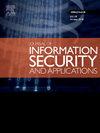增强软件定义网络的安全性:利用同态加密保护隐私的入侵检测
IF 3.8
2区 计算机科学
Q2 COMPUTER SCIENCE, INFORMATION SYSTEMS
Journal of Information Security and Applications
Pub Date : 2025-05-11
DOI:10.1016/j.jisa.2025.104084
引用次数: 0
摘要
本文通过将同态加密(HE)与深度神经网络(dnn)相结合,提出了一种新的软件定义网络(sdn)隐私保护入侵检测框架。该框架在使用DNN模型执行入侵检测分析之前,先使用HE对网络流量进行加密,确保数据机密性,同时实现健壮的威胁检测。提出的方法包括对数据集进行加密,在加密数据上训练基于dnn的入侵检测模型,并在SDN架构中部署该模型。主要研究结果表明,深度神经网络在加密数据上达到了很高的准确率(87.11%),与未加密数据(99.99%)的性能相当,表明其适合安全应用。相比之下,传统的机器学习模型,如逻辑回归、随机森林和决策树,在加密数据上的准确性低于在未加密数据上的表现。加密和未加密数据集之间DNN的最小性能差异突出了其对优先考虑安全和隐私的应用程序的有效性。提议的框架在关键阶段(从数据收集到应用程序部署)集成了加密,并利用SDN控制器和开放流交换机等强大的控制机制来加强整体安全态势。这项研究代表了在sdn中实现保护隐私的入侵检测的重要一步,有助于持续努力增强网络安全,同时保护数据隐私免受不断变化的网络安全威胁。本文章由计算机程序翻译,如有差异,请以英文原文为准。
Enhancing security in software defined networks: Privacy-preserving intrusion detection with Homomorphic Encryption
This study proposes a novel privacy-preserving intrusion detection framework for software-defined networks (SDNs) by integrating Homomorphic Encryption (HE) with Deep Neural Networks (DNNs). The framework encrypts network traffic using HE before performing intrusion detection analysis with a DNN model, ensuring data confidentiality while enabling robust threat detection. The proposed approach involves encrypting the dataset, training the DNN-based intrusion detection model on encrypted data, and deploying the model within the SDN architecture. Key findings demonstrate that the DNN achieves high accuracy (87.11 %) on encrypted data, comparable to its performance on unencrypted data (99.99 %), indicating its suitability for secure applications. In contrast, traditional machine learning models such as Logistic Regression, Random Forest, and Decision Tree exhibit decreased accuracy on encrypted data compared to their performance on unencrypted data. The minimal performance difference of the DNN between encrypted and unencrypted datasets highlights its effectiveness for applications prioritizing security and privacy. The proposed framework incorporates encryption at critical stages, from data collection to application deployment, and leverages robust control mechanisms like SDN controllers and open flow switches to strengthen the overall security posture. This study represents a significant step towards achieving privacy-preserving intrusion detection in SDNs, contributing to ongoing efforts to enhance network security while safeguarding data privacy against evolving cybersecurity threats.
求助全文
通过发布文献求助,成功后即可免费获取论文全文。
去求助
来源期刊

Journal of Information Security and Applications
Computer Science-Computer Networks and Communications
CiteScore
10.90
自引率
5.40%
发文量
206
审稿时长
56 days
期刊介绍:
Journal of Information Security and Applications (JISA) focuses on the original research and practice-driven applications with relevance to information security and applications. JISA provides a common linkage between a vibrant scientific and research community and industry professionals by offering a clear view on modern problems and challenges in information security, as well as identifying promising scientific and "best-practice" solutions. JISA issues offer a balance between original research work and innovative industrial approaches by internationally renowned information security experts and researchers.
 求助内容:
求助内容: 应助结果提醒方式:
应助结果提醒方式:


